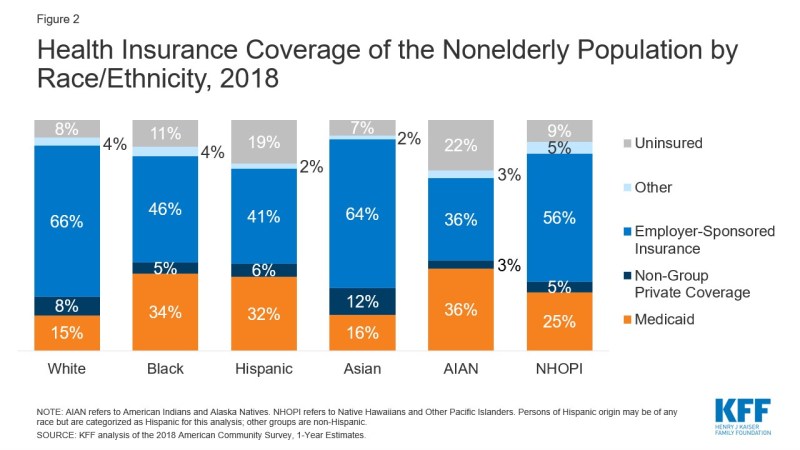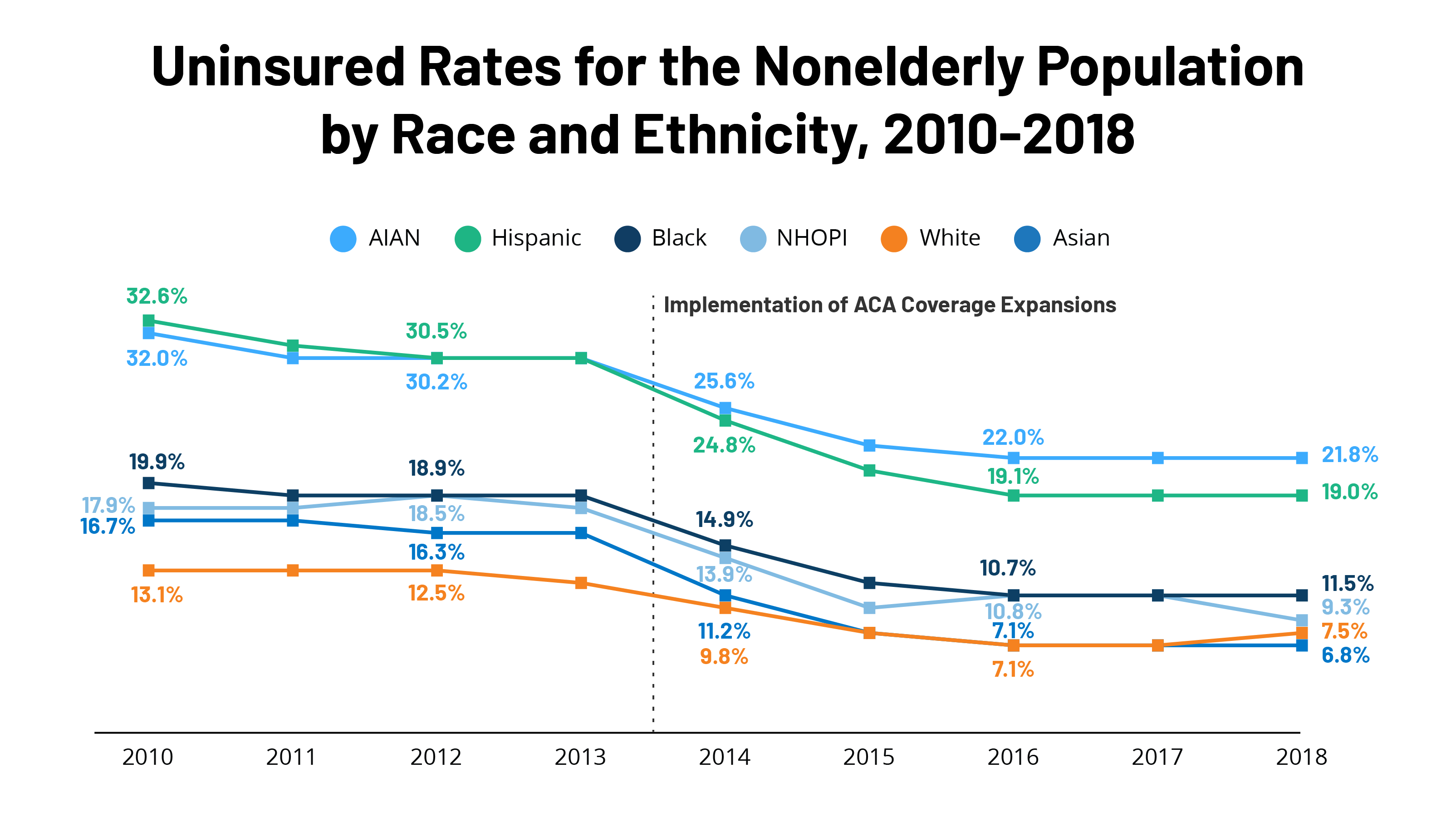In November, the Supreme Court is due to hear arguments on a court challenge, backed by the Trump administration, that seeks to overturn the Affordable Care Act (ACA). As noted in a previous KFF analysis, the result will have major effects on the entire healthcare system, as the provisions of the law have affected nearly all Americans in one way or another. One of the most important aspects of ACA has been its expansion of health coverage options through the extension of Medicaid to low-income adults and the creation of health insurance markets with grants to help people with buy a blanket. This analysis shows that these new coverage options have contributed to significant gains in coverage, especially among people of color, helping to reduce long-standing racial disparities in health coverage. The loss of these coverage pathways, especially the expansion of Medicaid, would likely lead to disproportionate coverage losses among people of color, increasing disparities in coverage, access to care and health outcomes. .
Before the ACA, people of color were much more likely to be uninsured than white people. The higher uninsured rates among the colored groups reflected limited access to affordable health coverage options. Although the majority of individuals have at least one full-time worker in the family across racial and ethnic groups, people of color are more likely to live in low-income families that do not have coverage offered by a family. employer or having difficulty paying for private services. coverage when available. While Medicaid has helped fill some of this gap in private coverage for color groups, prior to ACA eligibility for Medicaid for parents was limited to those with very low incomes (often below 50%). the poverty line) and adults without dependent children, regardless of poverty – were not eligible under federal rules.
People of color have enjoyed significant gains in ACA coverage, which has helped to reduce but not eliminate disparities in health coverage. Coverage rates increased for all racial / ethnic groups between 2010 and 2016, with the largest increases occurring after the implementation of the ACA Medicaid and Marketplace extensions of coverage in 2014 (Figure 1). Overall, nearly 20 million non-elderly people were covered during this period, including nearly 3 million Blacks, over 5 million Hispanics and over 1 million Asians. Among the non-elderly population, Hispanics experienced the largest percentage point decline in their uninsured rate, which fell from 32.6% to 19.1% between 2010 and 2016. The Islanders (NHOPI) also experienced larger percentage point drops in their uninsured rates compared to their white counterparts during this period. These coverage gains narrowed the percentage point differences in uninsured rates between certain color groups and whites, but the disparities persisted. Most color groups remained more likely to be uninsured compared to whites. In addition, the relative risk of being uninsured compared to Whites did not improve for some groups. For example, blacks remained 1.5 times more likely to be uninsured than whites, and the rate of uninsured among Hispanics remained more than 2.5 times higher than the rate for whites.
Figure 1: Uninsured rate for the non-elderly population by race and ethnicity, 2010-2018
Between 2016 and 2017, and continuing into 2018, coverage gains stagnated and began to reverse for some groups. During this period, there were small but statistically significant increases in the uninsured rates for whites and blacks among the non-elderly population, from 7.1% to 7.5% and from 10%. , 7% to 11.5% respectively. Among children, there was also a statistically significant increase in the uninsured rate for Hispanic children, which rose from 7.6% to 8.0% between 2016 and 2018. Recent data further shows that the number of uninsured continued to grow in 2019 despite improvements in the economic situation of households. measures and indicate that the largest increases between 2018 and 2019 were seen among Hispanics. The growth in the number of uninsured people likely reflects a combination of factors, including reduced awareness and enrollment efforts for ACA coverage, changes to Medicaid renewal processes, public charge policies and elimination. the individual mandate penalty for health coverage.
The ACA offers coverage options for people who lose their jobs due to the economic downturn associated with the pandemic. The economic fallout from the coronavirus pandemic has resulted in historic levels of job losses. As people lose their jobs, many may face disruptions in their health coverage, as most people in the United States get their insurance through their jobs. Initial KFF estimates on the implications of job loss found that nearly 27 million people were at risk of losing employer-sponsored health coverage due to job loss. Many of these people may have retained their coverage, at least for the short term, under ongoing leave or benefit agreements by employers after layoffs. However, the health coverage options made available by the ACA have provided options for people who lose employer-sponsored coverage that might otherwise no longer be insured. Following the decline in registrations in 2018 and 2019, recent data indicates that Medicaid registrations increased by 2.3 million or 3.2% from February 2020 to May 2020. Additionally, in May 2020, the data enrollment reveals that nearly 500,000 people were covered by Marketplace through a Special Enrollment Period (SEP), in most cases due to the loss of employment-based coverage. The number of people with Marketplace coverage through a SEP in April 2020 increased by 139% compared to April 2019 and by 43% in May 2020 compared to May 2019.
People of color would likely experience the greatest coverage losses if ACA coverage options were eliminated. In the absence of the ACA, states would lose the ability to cover adults without dependent children through Medicaid under federal rules. They would also lose access to enhanced federal funding provided to cover expanding adults. As such, states would face challenges maintaining coverage for adults without children or dependent parents, and many would likely cancel that coverage, eliminating a coverage option for millions of low-income parents and adults without dependent parents. child who do not have access to other affordable coverage. In addition, without federal subsidies, many people could not afford private coverage. Since people of color experienced larger coverage gains under the ACA compared to their white counterparts, they would likely also experience larger coverage losses if these coverage options were eliminated.
Losing the expansion of Medicaid, in particular, would likely lead to disproportionate coverage losses among people of color, contributing to worsening disparities in coverage, access and use of care, and outcomes for people of color. health. Overall, among the non-elderly population, about one in three black, Hispanic, and IAAN people are covered by Medicaid, compared to 15% of white people (Figure 2). In addition, research shows that extending ACA Medicaid to low-income adults has helped reduce racial disparities in health coverage, helped improve access and uptake of care between groups, and reduced disparities in health outcomes for black and Hispanic people, particularly for measures of maternal health.

Figure 2: Health insurance coverage of the non-elderly population by race / ethnicity, 2018
In short, the outcome of the ongoing legal challenge to quash the ACA will have effects that will sweep across the health care system and affect nearly all Americans. These effects could include widening racial disparities in health coverage and health care, at a time when the emphasis is increasingly on prioritizing and promoting equity in health and community settings. a pandemic that has disproportionately affected people of color in the United States. Without extensions to ACA coverage, people of color would likely face growing gaps in health insurance coverage, contributing to and exposing greater barriers to healthcare and worse health outcomes. at an increased risk of medical debt and financial problems due to health care costs.

